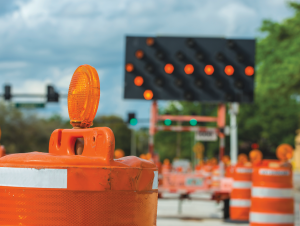Ultimate Headache
Construction-related road woes aren’t going away any time soon, but state officials say some relief can be had now.
 A College Park resident, Michael Riley has worked in the Dr. Phillips area for nearly a decade. Accordingly, and despite the inherent minor headaches, his commute has involved a 10-mile stretch of Greater Orlando’s primary, always-congested artery: I-4.
A College Park resident, Michael Riley has worked in the Dr. Phillips area for nearly a decade. Accordingly, and despite the inherent minor headaches, his commute has involved a 10-mile stretch of Greater Orlando’s primary, always-congested artery: I-4.
Until last year, that drive took him 30 minutes each way on a fairly consistent basis. Then came the massive, 21-mile, $2.3-billion I-4 Ultimate project—and like countless other drivers in the region, Riley’s minor headaches have transformed into what one could call an “Ultimate” headache.
“Over the past six months or so, it’s become a guessing game as to how long it’ll take [to get to or from work],” he says. “I used to leave 40 minutes before and it was never a problem. Now, I leave an hour early and still wind up late from time to time. Fortunately, I have an understanding employer.”
Riley is far from the only local suffering from road-construction woes, and I-4 Ultimate is far from our region’s only current roadwork. As of press time, more than 20 different projects are impacting thoroughfares in Orange, Osceola and Seminole counties, with plenty more on the way.
The good news? Once complete, these undertakings are expected to improve our quality of life and remove some of the hassle from getting around in Greater Orlando. More importantly for residents desperate to relieve their own ultimate headaches, state officials say that alternate routes— and even alternate modes of transportation—are ready to help.
Method Behind the Madness
For all the creative cursing that I-4 Ultimate and other projects have generated, the fact that they’ll eventually be a boon to the region sometimes gets lost in the shuffle.
“I-4 Ultimate has several goals: replacing our aged infrastructure, increasing capacity [and] providing a safer road by updating to today’s standards,” says Loreen Bobo, construction program manager for the project. “These combined will provide less daily delay to the driver.” Bobo notes that, beyond being inconvenient, those delays can be costly. Per the latest available figures, congestion costs drivers across the country an average of $960 per year—and in Greater Orlando, that annual average is $1,044. “If we can improve your commute by getting you through the corridor more quickly,” says Bobo, “your costs of sitting in traffic will go down.”
One of the more controversial aspects of I-4 Ultimate is the addition of paid express lanes, colloquially referred to by many as “Lexus lanes,” that will enable commuters to literally take the fast lane—assuming they can afford the cost. “Express lanes, dynamically priced to maintain 50 mph, will give drivers a dependable travel option along the I-4 corridor that we don’t have today,” says Jessica Ottaviano, public information specialist with the Florida Department of Transportation (FDOT).
Although the exact costs are to be determined, the lanes will inarguably provide a huge benefit for those who absolutely, positively need to be somewhere quickly.
“By adding the express lanes, which will have a dynamic toll that changes based on the congestion in the lanes, you will be able to help manage your daily drive through the I-4 corridor,” says Bobo. “Running late for an appointment, you may choose to pay the dynamic toll. You choose if it’s worth it to you on that day to pay to use the express lanes or not, or use the non-tolled general-use lanes, which will remain free to use.”
Another project that should help alleviate traffic issues is the expansion of the Wekiva Parkway (S.R. 429) so it connects to S.R. 417, completing the beltway around northwest metropolitan Orlando. “The 25-mile tolled expressway will provide an alternative to Interstate 4 and relieve U.S. 441, S.R. 46 and other area roads of traffic construction resulting from growth and travel between Orange, Lake and Seminole counties,” says Ottaviano.
While I-4 Ultimate’s promised relief isn’t expected to be fully realized until 2021, sections of it will be finalized long before the last worker clocks out. “We have opened several new bridges to traffic, which allows us to do more significant shifts in traffic so that we can reconstruct the interstate,” says Bobo. In the meantime, options are available for those looking to minimize their frustration today.
Recalculating Your Route
Beth DiSilvio wasn’t as lucky as Riley when it came to a forgiving employer. A single mother and cosmetician who used to commute from east Orlando to Millenia, work being done to the I-4/S.R. 408 interchange nearly doubled what had been a relatively easy 25-minute drive.
“I have one kid in school and a second in daycare,” she explains. “Between getting them ready and fighting traffic, I wound up being late more often than [my boss] would have liked.”
With tensions rising at work and it not being possible for her to leave earlier due to her children’s schedules, DiSilvio ultimately opted to find a new job closer to home. Before your commute leads you to such extremes, though, you might want to explore some potential sanity-savers.
“The Waze application [for iPhones and Android devices] is a really great way to find real-time, traffic-related information,” says Bobo. “Waze uses data from FDOT and other state DOTs, as well as user input, to provide suggested routes. These routes may change based on incidents occurring at the time, lane closures, accidents, etc.”
Depending on where you live, SunRail— Greater Orlando’s commuter rail that services Orange, Seminole and Volusia counties—might also be an option. (Even though SunRail improvements are, somewhat ironically, currently adding to the area’s construction issues.)
“An expansion of [SunRail] into Osceola County is currently under construction and should be complete by mid-2018,” says Ottaviano. “An expansion is planned to DeLand in Volusia County based on funding availability. The rail also has a study underway to offer service directly to Orlando International Airport.”
For those with a relatively short commute, biking or even walking are other possibilities. “Bicycle and pedestrian trails are also being expanded,” says Ottaviano. “Many segments will add or improve trails throughout Florida.”
If all else fails, invest in some good audiobooks, learn some meditation techniques and try to make the most of it. After all, and despite its name, I-4 Ultimate likely won’t be the final word on major road construction in our area: FDOT officials are already conducting the I-4 Beyond the Ultimate Project Development and Environment Reevaluation Study. If that moves forward, then we can probably look forward to doing it all again once I-4 Ultimate wraps up.
This article originally appeared in Orlando Family Magazine’s June 2017 issue.









